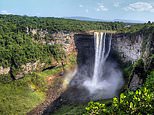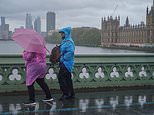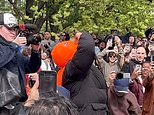
There are two good reasons for going on holiday: to seek adventure, and to find perfect peace.
These two things may sound mutually exclusive, but they’re not. Far from it. Most decent trips give you a fair mixture of both — and that counts double if you’re looking for wildlife.
When I went to Guyana I found both peace and high adventure just 12 hours apart. As things worked out, I got the peace first and the adventure second. In traditional story-telling they usually come the other way round, so I’ll stick with that and give you the adventure first.
But before that, I’d better say something about Guyana: and the first thing to learn is that it’s unique. It was formerly British Guiana and it’s the only English-speaking cricket-playing country on mainland South America (The nation swapped the ‘I’ for a ‘Y’ when Guyana became independent in 1966.). You’ll find it up there on the top right-hand corner; the great West Indies captain Clive Lloyd was born in Guyana.
Perhaps the most important fact is that it’s one of the most sparsely populated nations on Earth: with only around 800,000 people in the whole country, and most of them live in the capital, Georgetown and along the coast. It follows that you don’t have to travel far to find wild places.
Exotic: During his visit to Guyana, Simon Barnes stopped at Kaieteur Falls (pictured). ‘It’s a place that commands attention,’ he writes
Simon says that in Guyana (pictured) ‘you don’t have to travel far to find wild places’. While there, he spied ‘unbroken expanses of rainforest that look like the world’s biggest collection of broccoli’
Simon reveals that Guyana is one of the most sparsely populated nations on Earth
When you take off from Georgetown and head south you see a lot of green below: unbroken expanses of rainforest that look like the world’s biggest collection of broccoli. Before long we were sitting round the table at Karanambu Lodge, which was once a family cattle ranch and now a thrilling eco-tourism destination. Those who have sat around the same table before me include Sir David Attenborough, who came here while filming one of his earliest series, Zoo Quest to Guiana in 1955, and naturalist Gerald Durrell, author of My Family And Other Animals, who wrote up his animal-collecting trip here in Three Singles To Adventure.
Adventure was the Guyanese town that had appealed to his imagination. Durrell tells of a Marx Brothers-style adventure at Karanambu in which he somehow captured a giant anteater. We set out in pursuit of another one early next morning, but with cameras and binoculars rather than lassos.
The trouble with a target species is that you’ve got to find it if you want a satisfactory experience. It’s all very well enjoying the laconic song of the eastern meadowlark and the imposing presence of the jabiru stork, but I’d always longed to see a giant anteater and it appeared we were going to miss out.
We were bucketing about the savannah in a 4×4 and sightings of the laughing falcon weren’t convincing everybody of the value of this trip. We turned round: an endless plain with a lone mounted figure. This was Francis the vaquero, or cowboy, and he and his horse were staring at a bush.
We walked across to the bush and gazed too… and from it emerged one of the unlikeliest animals you would ever see if you were to travel the length and breadth of the Earth. It was indeed a giant anteater: more than six feet long, a massive bushy tail and a face so narrow it was almost a tube. This extended a good foot; it had no teeth, a tiny mouth and a tongue that can extend its length by a good 18 inches. It can deploy this tongue 160 times a minute as it laps up ants and termites in astronomical numbers, ripping their mounds apart with slashing claws.
It was decorated with subtle stripes and it was hardly bothered by us at all, staying in sight for a good few minutes as it pursued its strange, highly specialised existence. I would cross the world for a wild sight that lasts a couple of seconds: this anteater was far more generous than that. I had fulfilled a lifetime ambition, just as I had fulfilled another the previous evening. This was the peaceful one.
Simon visited Karanambu Lodge (pictured), which was ‘once a family cattle ranch and now a thrilling eco-tourism destination’
THINGS YOU MIGHT NOT KNOW ABOUT GUYANA Guyana means ‘land of many waters’ in its indigenous language.The population is about 800,000 (roughly the same as Leeds).Christopher Columbus was the the first European to see the country, in 1498.Georgetown, the capital, is named after George III.Gothic St George’s Cathedral was once the world’s tallest wooden building.Rare harpy eagles can be spotted in the Kanuku mountains.Jaguars, South America’s largest cat, and pumas can also be seen.The Kaieteur Falls cascade 226m — four times the height of Niagara Falls.Mount Roraima is a giant table mountain of 2 million-year-old rock.Guyana achieved independence in 1966 and is a member of the Commonwealth.
Guyana is an Amerindian word that means land of many waters: Karanambu is close to the Rupununi river and a gentle boat ride along its main course and its many meanders, backwaters and lakes is a joyous thing. We travelled sweetly on, past kingfishers and hummingbirds, along waterways walled and in places roofed by the dense riverine forest until, with the light fading, we emerged on to a lake of lilies.
Not just any lilies: these were the giant Amazonian waterlily, Victoria amazonica, with lilypads six feet across and flowers that can span 18 inches. The underside of each leaf gets its strength from a beautiful system of lattice. (Joseph Paxton borrowed the idea to make the Crystal Palace for the Great Exhibition of 1851.)
The massive blooms last only a couple of days. Each one produces its own heat, which attracts scarab beetles and then it closes, trapping the beetles inside. It releases them the following day and off they go to spread the lily’s pollen elsewhere. We sat silent in our boats drinking rum punch while the rain fell with exquisite gentleness on an impossible vista of beauty. Perfect peace and great adventure … but the trip had other wonders as well.
Kaieteur Falls is twice as tall as Victoria and four and half times taller than Niagara: the world’s largest single-drop waterfall with a plummet of 741 ft. It’s a place that commands attention, filling the ears with the thunder of the falls, the water stained deep tea-colour from fallen leaves and there, whizzing behind the great falls, were white-chinned swifts.
There was an unexpected treat here, one that caused me to gasp with shock and delight: a few steps along a side-path in the spray-soaked forests that surround the falls, three birds sat on braches giving each other old-fashioned looks. They were the size of smallish city pigeons — and the brightest orange you have ever seen, a preposterously un-bird-like colour, and their whole faces seemed walled up in even more orange feathers. These were Guianan cock-of-the-rock: the males compete with each other by way of extreme colour, while the females do the actual choosing. You can make your own joke about human behaviour here according to taste, but the birds themselves were enough for me.
In the market: There are only around 800,000 people living in Guyana, and most of them live in the capital, Georgetown. Above, a local selling citrus fruit in the city
Simon recalls seeing many ‘extravagant’ birds during his trip. Above, a brightly coloured hornbill
Then we were back in Georgetown for food and drink, all pleasant enough. The people, from mixed heritages that include African, Indian and Amerindian, create a pleasant atmosphere without oppressing you with it; you will score points if you can cope with the many excellent chilli sauces that come with the food. The local wiri-wiri pepper is not something to take lightly.
Guyana is changing: large off-shore resources of crude oil are bringing greater prosperity. Every visitor hopes they will navigate the journey well, taking the route that leads towards greater comfort for all without damaging the essential good vibes of the place.
I made the journey back to Georgetown with my head abuzz with wildlife: and even here there were still treasures to be found. In the botanical gardens we found the gorgeous red and green macaw and the toco toucan: birds of extravagant fantasy that turned out to be real.
And a last memory: looking out over the sea before we headed back for hotel and packing and airport, over the rich silt of the shore a bird that glowed red like a hot coal on a heap of nutty slack. Here was a scarlet ibis: and, as I watched, it took to the air and caught the sun and for an instant the sky was in flame.
Durrell understood the euphoria that comes from the best experiences in wild places, and he wrote about it in Three Singles: ‘In a state of intoxicated happiness you feel that you would not only forgive your friends the wrongs they had done you, but even your relatives.’ I raised a last glass to him and boarded the plane home.
TRAVEL FACTS
Return flights to Georgetown from Gatwick from £551 (ba.com). A nine-day ‘Guyana in Living Colour’ tour with Wilderness Explorers, including accommodation, transfers, guided activities and some meals from £3,088 pp (wilderness-explorers.com).
Source link
CHECK OUT: Top Travel Destinations
READ MORE: Travel News



